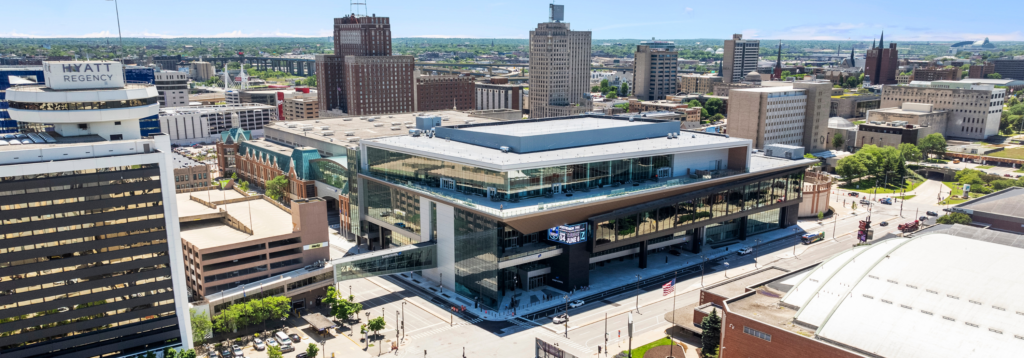Real Estate Spotlight: How a series of catalytic projects transformed Westown from a dead zone into a downtown hot spot
If you were shopping for office space in downtown Milwaukee 10 or 15 years ago and asked to look for a space west of the Milwaukee River, your broker would probably have tried to talk you out of it.
Today, looking at the amount of development Westown has seen in just the past three years – from The Avenue and 3rd Street Market Hall to the glittering renovation of the Warner Grand Theatre by the Milwaukee Symphony Orchestra and the emergence of the bustling Deer District – it’s hard to believe the neighborhood was ever considered low rent.
But it was.
When longtime Milwaukee real estate attorney Steve Chernof was tapped by former Mayor Tom Barrett in 2014 to form a task force to help revitalize West Wisconsin Avenue and the surrounding area, Chernof said people thought he was crazy for saying “yes.”
“I had friends that said to me: ‘Why are you doing this? You are wasting your time; it’s going to be a blot on your reputation,’” he said.
That attitude, said Chernof, of Godfrey & Kahn, was born largely out of the reputation Westown had as a forgotten and unloved part of downtown, compared to the East Town neighborhood where downtown’s class A office towers are located.
“If a business came to a commercial real estate broker looking for space and asked, ‘What about West Wisconsin Avenue?’ brokers would actively say, ‘Oh, you don’t want to do that. No one will go there,’” Chernof said. “They don’t say that anymore. Now people talk about moving to West Wisconsin Avenue.”
Part of the reason for the area’s new-found success can be traced to the efforts of the Wisconsin Avenue Milwaukee Development Corp. – the group that Chernof and others formed to help jump start redevelopment efforts.
But it can also be tied to basic market forces, such as developers running out of potential adaptive reuse projects east of the river, and the serendipity of having four key entertainment and tourism projects in the neighborhood all kick off around the same time, said Bill Bonifas, executive vice president at CBRE in Milwaukee.
CBRE represented civil engineering firm GRAEF, which moved its headquarters to The Avenue in 2019, and Bonifas and his team represented Fiserv in its lease negotiations to move its headquarters to the adjacent HUB640 building.
Bonifas sees the change of Wisconsin Avenue from a down-at-heel, Class C office market to what it is today as one that can be traced back to those distinct developments – and a handful of apartment conversions – that together made Westown more attractive to office space seekers.
Tony Lindsay, principal of asset management at Chicago-based North Wells Capital LLC, agrees. When the private equity commercial real estate investment firm purchased the former Bon-Ton building (now HUB640) at 640 Vel R. Phillips Ave. in 2017, the idea of securing a big-name tenant like Fiserv was just a far-off dream. But Lindsay said the company felt confident betting on the building, and on Westown.
“The reality is we invested in that building because we liked the story of Westown,” Lindsay said. “Now, all of a sudden, you’re going to go down West Michigan Street and you’re going to have Rexnord, you’re going to have We Energies, you’re going to have Milwaukee Tool, you’re going to have Fiserv, and this is all of a sudden going to be this corporate row of real quality, high-credit tenants.”
Asked why they decided to move to Westown, leaders at Fiserv and GRAEF had similar things to say.
“When GRAEF made the decision to move our corporate headquarters, we had full confidence in the vision set forward to revitalize Westown,” said Pat Kressin, vice president of business development and principal of the firm. “GRAEF has a lot of pride in being an anchor tenant on this historic project.”
Bob Hau, chief financial officer at Fiserv, said the company saw a chance to be part of continuing the positive change in the Westown neighborhood.
“We selected the downtown location because of its vibrant commercial and residential community, which complements our commitment to diversity and inclusion,” Hau added.
As the City of Milwaukee continues efforts to beautify Westown, which includes spending millions of dollars on a bevy of pedestrian safety and traffic-calming projects, it aims to capitalize on recent momentum, said Lafayette Crump, commissioner of the Department of City Development.
“Our work is not done, and I look forward to witnessing the full potential and success of Westown in the years ahead,” said Crump.

